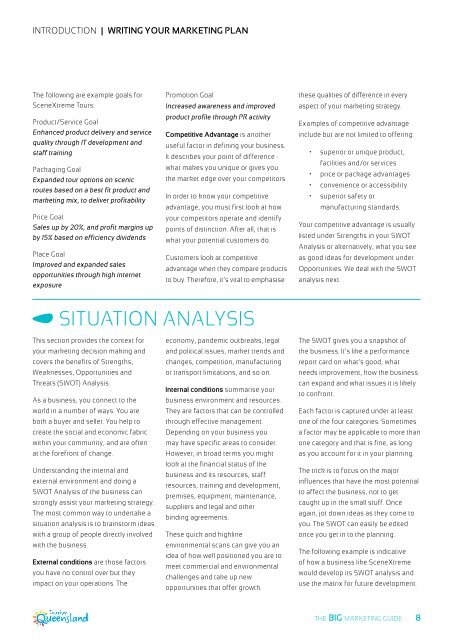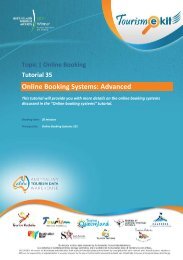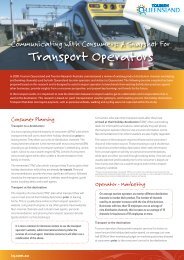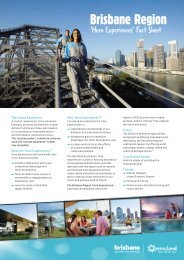Section 1: Introduction - Tourism Queensland
Section 1: Introduction - Tourism Queensland
Section 1: Introduction - Tourism Queensland
Create successful ePaper yourself
Turn your PDF publications into a flip-book with our unique Google optimized e-Paper software.
INTRODUCTION | Writing your marketing plan<br />
The following are example goals for<br />
SceneXtreme Tours:<br />
Product/Service Goal<br />
Enhanced product delivery and service<br />
quality through IT development and<br />
staff training<br />
Packaging Goal<br />
Expanded tour options on scenic<br />
routes based on a best fit product and<br />
marketing mix, to deliver profitability<br />
Price Goal<br />
Sales up by 20%, and profit margins up<br />
by 15% based on efficiency dividends<br />
Place Goal<br />
Improved and expanded sales<br />
opportunities through high internet<br />
exposure<br />
Promotion Goal<br />
Increased awareness and improved<br />
product profile through PR activity<br />
Competitive Advantage is another<br />
useful factor in defining your business.<br />
It describes your point of difference -<br />
what makes you unique or gives you<br />
the market edge over your competitors.<br />
In order to know your competitive<br />
advantage, you must first look at how<br />
your competitors operate and identify<br />
points of distinction. After all, that is<br />
what your potential customers do.<br />
Customers look at competitive<br />
advantage when they compare products<br />
to buy. Therefore, it’s vital to emphasise<br />
these qualities of difference in every<br />
aspect of your marketing strategy.<br />
Examples of competitive advantage<br />
include but are not limited to offering:<br />
• superior or unique product,<br />
facilities and/or services<br />
• price or package advantages<br />
• convenience or accessibility<br />
• superior safety or<br />
manufacturing standards.<br />
Your competitive advantage is usually<br />
listed under Strengths in your SWOT<br />
Analysis or alternatively, what you see<br />
as good ideas for development under<br />
Opportunities. We deal with the SWOT<br />
analysis next.<br />
Situation analysis<br />
This section provides the context for<br />
your marketing decision making and<br />
covers the benefits of Strengths,<br />
Weaknesses, Opportunities and<br />
Threats (SWOT) Analysis.<br />
As a business, you connect to the<br />
world in a number of ways. You are<br />
both a buyer and seller. You help to<br />
create the social and economic fabric<br />
within your community, and are often<br />
at the forefront of change.<br />
Understanding the internal and<br />
external environment and doing a<br />
SWOT Analysis of the business can<br />
strongly assist your marketing strategy.<br />
The most common way to undertake a<br />
situation analysis is to brainstorm ideas<br />
with a group of people directly involved<br />
with the business.<br />
External conditions are those factors<br />
you have no control over but they<br />
impact on your operations. The<br />
economy, pandemic outbreaks, legal<br />
and political issues, market trends and<br />
changes, competition, manufacturing<br />
or transport limitations, and so on.<br />
Internal conditions summarise your<br />
business environment and resources.<br />
They are factors that can be controlled<br />
through effective management.<br />
Depending on your business you<br />
may have specific areas to consider.<br />
However, in broad terms you might<br />
look at the financial status of the<br />
business and its resources, staff<br />
resources, training and development,<br />
premises, equipment, maintenance,<br />
suppliers and legal and other<br />
binding agreements.<br />
These quick and highline<br />
environmental scans can give you an<br />
idea of how well positioned you are to<br />
meet commercial and environmental<br />
challenges and take up new<br />
opportunities that offer growth.<br />
The SWOT gives you a snapshot of<br />
the business. It’s like a performance<br />
report card on what’s good, what<br />
needs improvement, how the business<br />
can expand and what issues it is likely<br />
to confront.<br />
Each factor is captured under at least<br />
one of the four categories. Sometimes<br />
a factor may be applicable to more than<br />
one category and that is fine, as long<br />
as you account for it in your planning.<br />
The trick is to focus on the major<br />
influences that have the most potential<br />
to affect the business, not to get<br />
caught up in the small stuff. Once<br />
again, jot down ideas as they come to<br />
you. The SWOT can easily be edited<br />
once you get in to the planning.<br />
The following example is indicative<br />
of how a business like SceneXtreme<br />
would develop its SWOT analysis and<br />
use the matrix for future development.<br />
THE BIG MARKETING GUIDE<br />
8

















